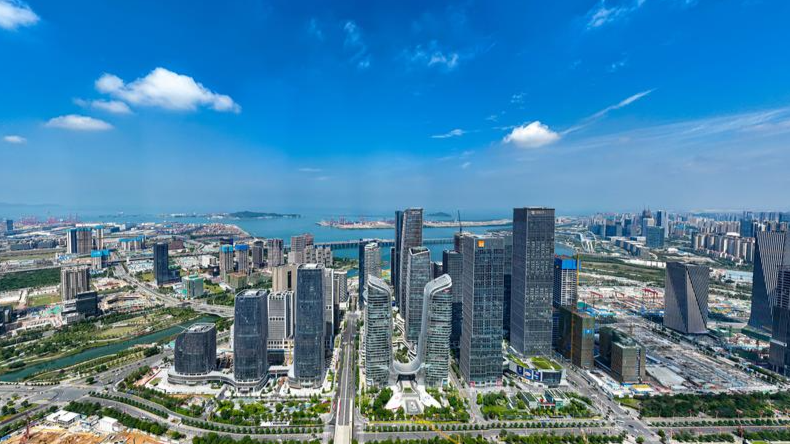
Qianhai’s role in boosting the Shenzhen-Hong Kong collaboration has improved over the past four years, with its better business environment, diversified industry structure and more comprehensive cooperative fields, experts said.
Their remarks came ahead of the fourth anniversary of the promulgation of the Plan for Comprehensive Deepening Reform and Opening Up of the Qianhai Shenzhen-Hong Kong Modern Service Industry Cooperation Zone. The plan was released by the Communist Party of China Central Committee and the State Council on Sept 6, 2021.
Deepening integration between Shenzhen and Hong Kong was listed as one of the four major strategic roles that the zone would play, along with establishing a pilot platform for comprehensive reform and innovation, and providing a pivot for high-level international openness and a highland for the high-quality development of modern service industries.
READ MORE: Bay Area hotline set up to help HK youth develop in Qianhai
The blueprint set a target of increasing the number of Hong Kong-funded enterprises in Qianhai to 11,000 and providing jobs to 10,000 or more Hong Kong residents by 2025. The number of cross-border government services provided in Hong Kong and Macao should also reach 400 this year.
“Qianhai has made remarkable achievements and changes over the past four years,” Shi Kun, director of the department of regional development and planning at Shenzhen-based think tank the China Development Institute, said.
“In terms of Shenzhen-Hong Kong cooperation, the approach has evolved from a ‘one-way effort’ from Shenzhen to a more collaborative model, where Hong Kong government, businesses, educational institutions and people are engaging in mutual initiatives, establishing a two-way cooperation dynamic.”
The structure of the modern services industry has also been optimized, Shi said. “Previously dominated by finance and logistics, the modern services industry in Qianhai is now diversifying. There is a greater emphasis on information technology and knowledge-intensive sectors, reflecting a richer array of service offerings.”
Yu Haichun, director of the institute of international trade rules at the University of International Business and Economics, said he has observed a “significant improvement” in Qianhai’s business environment, which has played a vital role in attracting investment and fostering economic growth.
“Companies settling in Qianhai can truly feel a significant improvement in the business environment, which is gradually approaching world-class level, as it has integrated Hong Kong's best practices and advantages,” he said.
Yu also described the integration of institutional mechanisms in Qianhai as a noticeable advancement that “has exceeded expectations” over the past four years.
“Qianhai has taken the lead in bridging systems in the Guangdong-Hong Kong-Macao Greater Bay Area (GBA), particularly between the mainland and the two special administrative regions of Hong Kong and Macao. For example, if a Hong Kong or Macao enterprise faces a commercial dispute in Qianhai, it can choose to apply Hong Kong or Macao laws through agreements and select arbitration in either location,” said the scholar.
When it comes to the integration of Shenzhen and Hong Kong, as well as opening-up to the outside world, Wang Da, visiting professor of the Institute for International Affairs of the Chinese University of Hong Kong, Shenzhen, said Qianhai has moved beyond its early stage of purely economic cooperation and has gradually entered a new phase of coordinated development in social and people's livelihood sectors.
READ MORE: Foreign investment in Shenzhen's Qianhai exceeds $40b
The “1510” development model, launched by the Qianhai Shenzhen-Hong Kong Youth Innovation and Entrepreneur Hub (E-hub), has provided tangible support for Hong Kong people to start businesses and seek employment in the special economic zone, he said.
The “1” in the development model refers to providing qualified Hong Kong entrepreneurial teams with office space for just 1 yuan ($0.14) per square meter per month. The “5” means the establishment of a 500-million-yuan fund to support startups and entrepreneurs. And the “10” represents the provision of 100,000 square meters of industrial space to establish a vibrant innovation ecosystem.
“In turn, the cross-border flow of people has further promoted the integration of education, medical care and other people's livelihood fields between the two places, thereby better meeting Hong Kong residents’ needs, such as enrolling their children in schools and accessing medical services for the elderly,” Wang said.
Contact the writer at sally@chinadailyhk.com


